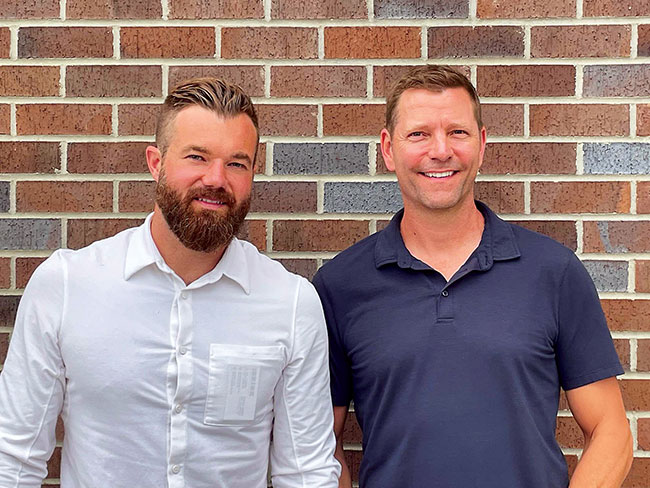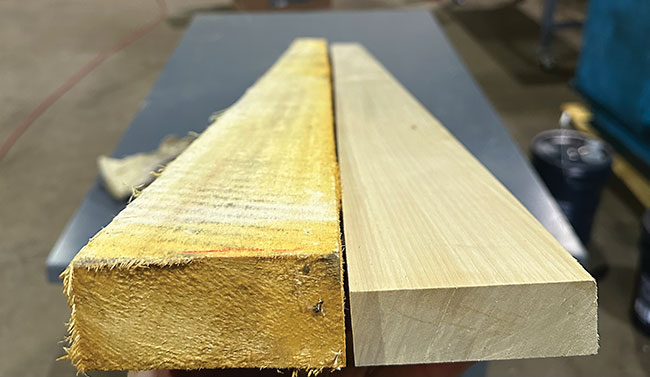
New life for Deadwood: B.C. project turns low-grade fibre into densified engineered wood
October 30, 2023
By Catherine Nutting and Qingcen Cai
A partnership between Nak’azdli Development Corporation and Deadwood Innovations is creating a new supply-chain stream for the low-end fibre market.
 Owen Miller, left, is the president of Deadwood Innovations and John-Paul (JP) Wenger is the CEO of Nak’azdli Development Corporation. Photo courtesy Deadwood Innovations.
Owen Miller, left, is the president of Deadwood Innovations and John-Paul (JP) Wenger is the CEO of Nak’azdli Development Corporation. Photo courtesy Deadwood Innovations. The Deadwood project in B.C. is an exciting, innovative manufacturing venture that entails a business partnership between Nak’azdli Development Corporation and Deadwood Innovations Ltd., aiming to revolutionize the forest sector.
They have developed an innovative process that converts low-grade timber and low-value lumber into a wood product that can be used as a substitute for lumber and timber in various applications.
The Deadwood project uses a hydro-thermal chemi-mechanical process that imparts strength and stability into the fibre. Engineering work is currently underway to scale-up from a pilot plant to a 30,000 cubic metre per-year commercial operation, in order to demonstrate the feasibility and commercial potential of this process. The pilot plant equipment was manufactured in Fort St. James, B.C.
With support from programs such as the B.C. Ministry of Forest’s Indigenous Forest Bioeconomy Program and the federal government’s Investments in Forest Industry Transformation program, this project is aligned with many of the priorities of different levels of government: supporting Indigenous leadership in the forest sector, reducing carbon emissions through its sequestration in wood products, and moving from high-volume to high-value.
The challenge
The forest sector faces challenges with efficiently utilizing low-grade timber and yielding higher prices from lumber due to natural disturbances in our forests. Extending the useful life of wood products contributes to a circular economy. Additionally, the project aims to mitigate climate change by storing carbon that would otherwise be released through burning or short-lived paper products, and by utilizing low-value logs and beetle-killed or fire-damaged trees.
The targeted log feedstock is not suitable for existing sawmilling technologies, and is currently being used for pulp or pellets, or is left in slash piles. Traditional lumber production heavily relies on high-grade logs and sawlogs, limiting the utilization of low-grade logs, deciduous logs, and broken lumber. Additionally, the natural variability and defects in lumber can present challenges in terms of consistency and quality.
The Deadwood technology provides a way to turn large amounts of underutilized fibre into saleable products.
“The technology presents an additional supply-chain stream for the current low-end off-spec fibre market,” says Owen Miller, president of Deadwood Innovations.
The process
The province supported Nak’azdli Whut’en First Nation’s priorities in the natural resource sector through a multi-phased bioeconomy project. This entailed supporting a partnership between Nak’azdli Development Corporation and Deadwood Innovations Ltd. to commercialize this novel forest bioproduct.

Densified aspen cant end view and densified aspen lumber. Photo courtesy Deadwood Innovations.
Deadwood’s proprietary technology converts low-grade timber into densified engineered cants, and low-value lumber into densified engineered lumber that substitutes for traditional lumber. The engineered wood products have properties comparable to hardwoods. The advantages of their product include the ability to use various feedstock sources, producing consistently stable, strong products, promoting circular economy practices, and storing carbon.
“The technology unlocks value that has always been present, but the current commercial suite of technologies is not able to do so,” Miller says.
The system manufactures engineered wood products using a feedstock of coniferous timber, damaged by wildfire or beetle infestation, as well as underutilized deciduous species. The process starts with dead timber that has dried in the field, or deciduous stands that are not economical for conventional lumber production at current standards due to pocket rot in the tree.
Logs are scanned and sorted by species, moisture content, and condition, and are then transferred to infeed. After debarking, the logs are densified and stabilized in a unique process that leverages and combines engineering principles from various manufacturing processes. The lumber upgrading process is similar but does not require debarking.
The resulting manufactured wood can range in density from that of a softwood to that of a hardwood simply through the pressing mechanism and lignocellulose reactions, not through the addition of resins. As the Deadwood partners explain, “A wide variety of dimensions and densities are attainable using our unique pressing process.”
The upgrading process that transforms low-quality fibre into a novel wood product has evolved through research and development and has been optimized for accelerated commercialization. Patents are pending for the inventions of the system.
The current pilot phase is being carried out on the Nak’azdli Reserve and will be completed in Spring 2024.
In addition to the current engineering phase of the project, as part of its carbon offset program, Deadwood is also gathering data, quantifying environmental benefits, and estimating sequestered emissions.
The partnership
At the heart of the venture is the vibrant partnership between Nak’azdli Development Corporation, the economic arm of the Nak’azdli Whut’en, and Deadwood Innovations. Nak’azdli Development Corp has a 20 per cent equity in the intellectual property company, and 51 per cent equity in the first commercial operating company. Nak’azdli members have board positions for governance representation, and defined rights for facility management and priority staffing.
The pilot plant is located on the former Tl’oh Forest Products site in Nak’azdli. The first commercial facility is currently being developed at the same location.
The project’s success depends upon the partnership that is at its core. The co-founders place great value on taking time to build up understanding and trust. In 2019, Deadwood Innovations was a new venture that had created preliminary samples.
Miller talks about how groundbreaking it was for Nak’azdli to support a forestry-technology start-up, and about how crucial that was to the project.
“Nak’azdli leadership and its members deserve recognition for their willingness to accept and manage risks in efforts to support a start-up in an emerging technological risk-averse sector. Piloting and research and development in resource manufacturing is very capital-intensive, and it can be challenging to determine product-market fit. Nak’azdli’s support demonstrates actionable reconciliation and leadership,” he says.
Miller advises that a partnership can go far when it is anchored in both trust and aligned intentions. Success comes through a shared focus on a co-developed strategy. He believes in the importance of engaging early, often, and transparently, with a development corporation board, and Chief and council, in a solution-focused attitude.
“Be honest about risks, challenges, and successes,” he says.
Next steps
The expected outcomes include the production of consistent, stronger, and stabilized engineered wood products, the promotion of a circular economy by extending product lifespan, and the storage of carbon within long-lived timber products. Furthermore, the project aligns with provincial priorities by supporting Indigenous partnership and economic development, advancing the bioeconomy pathway, and fostering forest industry diversification through value-added products.

A comparison of aspen lumber before (input) and after (densified). Photo courtesy Deadwood Innovations
Deadwood plans to develop a feedstock in the form of a blank or billet, suitable for a line of structural, industrial, decorative, and furniture products. A customer feedback and acquisition process has begun.
Deadwood Innovations is currently developing product specifications through collaborative testing at the University of Northern British Columbia’s Wood Innovation Research Lab. As the company explains, “The initial marketing strategy is to develop a line of products and get them into the hands of customers prior to commercial sanction.”
Initial target segments include using upgraded deciduous and coniferous lumber and timbers for building components such as nail- or dowel-laminated timber panels, decorative facades, and high-end furniture. Post-commercialization, industrial segments such as rail ties, and certified structural components, such as glue-laminated beams, are growth opportunities.
The carbon storage will translate into additional incentives. There is an urgent need to reduce carbon emissions and to promote circular economy practices in the community and in the province. The target log feedstock is not suitable for existing sawmilling technologies, and is currently being used for pulping or pellets.
“Deadwood is introducing a margin-added carbon storage technology that introduces an alternative to large-scale fiber combustion emissions intensive processes,” Miller explains.
Commercialization of the Deadwood project stands to provide diverse employment. The technology requires primarily in-house operations and training, and can be retrofitted into existing operating or shuttered sawmills.
Nak’azdli-Whut’en Chief Aileen Prince sums up the widespread enthusiasm for the project. “Successful commercialization of this project will stabilize and strengthen our economy, community, and environmental stewardship,” she says.•
Catherine Nutting is an Indigenous bioeconomy policy analyst and Qingcen Cai is the Indigenous bioeconomy program lead with the Innovation, Bioeconomy and Indigenous Opportunities Branch of the B.C. Ministry of Forests.
Print this page